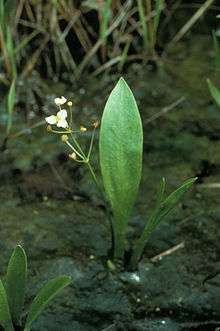Sagittaria fasciculata
Sagittaria fasciculata, the bunched arrowhead[1] (also known as duck potato, Indian potato, or wapato) is a plant found in wetlands. This plant produces edible tubers that were heavily collected by the Native Americans as a food source. STATUS: Endangered, Federal Register, July 25, 1979[2][3]
| Bunched arrowhead | |
|---|---|
 | |
| Scientific classification | |
| Kingdom: | Plantae |
| Clade: | Tracheophytes |
| Clade: | Angiosperms |
| Clade: | Monocots |
| Order: | Alismatales |
| Family: | Alismataceae |
| Genus: | Sagittaria |
| Species: | S. fasciculata |
| Binomial name | |
| Sagittaria fasciculata E.O. Beal | |
Description
Sagittaria fasciculata is a perennial herb up to 35 cm tall. Submerged leaves are long and narrow, round in cross-section. Emerging leaves are flat, broadly ovate or lanceolate.[4][5][6]
Distribution
Sagittaria fasciculata is only known to be found in Henderson and Buncombe Counties in North Carolina plus Greenville and Laurens Counties in South Carolina.[4][7]
Habitat
Sagittaria fasciculata is found in seepage areas with little to no flow. It prefers shaded areas on sandy loams.[4][8]
References
- "Sagittaria fasciculata". Natural Resources Conservation Service PLANTS Database. USDA. Retrieved 26 October 2015.
- Federal Register
- Buchanan, M.F. and J.T. Finnegan. 2010. Natural Heritage Program List of the Rare Plant Species of North Carolina. N.C. Natural Heritage Program, Raleigh, NC.
- Flora of North America v 22, Sagittaria fasciculata
- Beal, Ernest O. 1960. Journal of the Elisha Mitchell Scientific Society 76(1): 76, f. 3, map 5, Sagittaria fasciculata
- Service, U.S. Fish and Wildlife. "Raleigh Ecological Services Field Office". www.fws.gov. Retrieved 2017-01-30.
- Biota of North America Program, map, Sagittaria fasciculata
- Newberry, Gillian (1991-01-01). "Factors Affecting the Survival of the Rare Plant, Sagittaria fasciculata E. O. Beal (Alismataceae)". Castanea. 56 (1): 59–64. doi:10.2307/4033422. JSTOR 4033422.
External links
![]()
